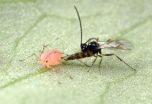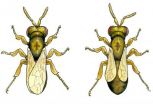Specific antipsychotic drugs increase risk of death in elderly dementia patients
Research: Differential risk of death in older nursing home residents prescribed specific antipsychotic medications: Population-based cohort study
2012-02-24
(Press-News.org) Nursing home residents over the age of 65 who take certain antipsychotic medication for dementia are at an increased risk of death, suggests a research paper published today on bmj.com.
The Harvard Medical School study, the largest ever undertaken among US nursing home residents, looked at 75,445 older nursing home residents from 45 US states between 2001 and 2005. All nursing home residents studied were 65 and over. Risks of mortality were looked at during a six month period.
The US Food and Drug Administration (FDA) warned in 2005 that atypical antipsychotic drugs are associated with an increased risk of mortality in elderly patients with dementia, but questions still remain on whether risks differ by drugs. This warning was expanded to include conventional antipsychotics in 2008. The authors report that despite these warnings, the use of these drugs is likely to continue because of the "continued growth of the dementia population" and the need for some type of intervention.
The study assessed mortality risks associated with individual antipsychotic drugs including aripiprazole, haloperidol, olanzapine, quetiapine, risperidone and ziprasidone.
Out of 75,445 nursing home residents, a total of 6,598 died within the six month study from non-cancer related causes. Patients treated with haloperidol had double the risk of death compared with those taking risperidone, while those taking quetiapine had a reduced risk. The effect of haloperidol was strongest during the first 40 days of treatment which did not change after a dose adjustment. Almost half of deaths (49%) were recorded as due to circulatory disorders, 10% to brain disorders and 15% to respiratory disorders.
Patient characteristics were adjusted for age, sex, clinical condition and the presence of physical illnesses that might raise risk of mortality, ethnicity, education and geographic location (US state) as were nursing home characteristics including facility size, occupancy rate, availability of special care units, staffing levels, ownership, resident characteristics and quality indicators.
In conclusion, the authors suggest that not all antipsychotic medication carries the same risk of death in elderly populations. They conclude, however, that "clinicians may want to consider this evidence when evaluating […] the best approach to treatment of behavioural problems".
In an accompanying editorial, Dr McCleery from the Oxford NHS Foundation Trust, argues that future research should work on identifying the key parts and efficacy of non-drug based interventions and how these can be implemented as simply and efficiently as possible.
INFORMATION: END
ELSE PRESS RELEASES FROM THIS DATE:
2012-02-24
In the war between parasite and host, the parasitic wasp, Aphidius ervi, and the pea aphid, Acyrthosiphon pisum, are locked in a battle for survival. New research published in BioMed Central's open access journal BMC Biology shows that this cunning parasite sniffs out differences between protected and unprotected aphids, and alters its egg-laying strategy, in order to overwhelm aphid defenses and ensure survival of wasp offspring.
The wasp, A. ervi, lays an egg inside the pea aphid, where the egg hatches and converts the aphid's insides into a wasp nursery. The wasp ...
2012-02-24
Spacious new homes on large, hillside homesites in Fair Oaks Ranch are coming to Santa Clarita at Crest View, where Los Angeles homebuilder Pardee Homes has set Saturday, March 3 for grand opening festivities. The Crest View sales center will open at 10 a.m. and home shoppers are invited to enjoy self-guided tours of 4 fully decorated model homes.
Grand opening visitors can also take in a lively session with Sandy Krogh of Culinary Consultants. Demonstrating Crest View's upscale G.E. appliance line in a model home kitchen, Sandy will present delicious and easy springtime ...
2012-02-24
Age-related macular degeneration (AMD) is one of the leading causes of blindness worldwide, especially in developed countries, and there is currently no known treatment or cure or for the vast majority of AMD patients. New research published in BioMed Central's open access journal Genome Medicine has identified genes whose expression levels can identify people with AMD, as well as tell apart AMD subtypes.
It is estimated that 6.5% of people over age 40 in the US currently have AMD. There is an inheritable genetic risk factor but risk is also increased for smokers and ...
2012-02-24
In recent years, a number of controversial claims have been made about the female mammal's egg supply – that it is renewed over her adult lifetime (as opposed to the conventional understanding that she is born with all of her eggs), and that the source of these eggs is stem cells that originate in the bone marrow. Now, Weizmann Institute scientists have disproved one of those claims and pointed in new directions toward resolving the other. Their findings, based on an original method for reconstructing lineage trees for cells, were published online today in PLoS Genetics.
The ...
2012-02-24
Scientists have discovered a new target in their fight against the devastating global disease 'malaria' thanks to the discovery of a new protein involved in the parasite's life cycle.
The research has uncovered a vital player in the sexual phase of the malaria parasite's reproduction which could prove an effective target for new treatments to stop the disease in its tracks.
The scientists from The University of Nottingham's School of Biology, with collaborators from the Universities of Leicester, Oxford, Imperial College London and Leiden in the Netherlands, have just ...
2012-02-24
CHICAGO --- Millions of "good" bacteria exist harmoniously on the skin and in the intestines of healthy people. When harmful bacteria attack, the immune system fights back by sending out white blood cells to destroy the disease-causing interlopers. But how do white blood cells know which bacteria are good and which are harmful?
Northwestern University Feinberg School of Medicine researchers studied one type of white blood cell known as a macrophage, which is among the immune system's first to detect and eliminate harmful bacteria. The research team, led by Christian ...
2012-02-24
Numerous mouse strains show great biological variation in features such as behavior, coat color and susceptibility to cancer and other diseases.
This study examines one possible genetic cause for differential gene expression and biological variation.
COLUMBUS, Ohio – The many short pieces of mobile DNA that exist in the genome can contribute to significant biological differences between lineages of mice, according to a new study led by researchers at the Ohio State University Comprehensive Cancer Center – Arthur G. James Cancer Hospital and Richard J. Solove Research ...
2012-02-24
How we move is an excellent indicator of overall health. When we feel good, we move around continually. When we're in pain, we reduce our physical activity. This observation might seem trivial, but it has led to an original approach for evaluating chronic pain. A team from EPFL's Laboratory of Movement Analysis and Measurement (LMAM) has developed a clever, easy-to-use visual tool to help doctors assess their patients' pain levels. The research appears online February 23 in the journal PLoS One.
"Movement is an objective indicator of pain. You move differently if you're ...
2012-02-24
The tiny, little-noticed jewel wasp may provide some answers as to how different species differ in size and shape. And that could lead to a better understanding of cell growth regulation, as well as the underlying causes of some diseases.
Using the wings of these insects as a tool to study how growth is regulated, biologists at the University of Rochester have discovered that changes in expression of a well-known cell regulator gene called "unpaired" (upd) accounts for wing growth differences between males of closely related species. Unpaired is distantly related to ...
2012-02-24
Researchers at National Jewish Health have discovered specific molecular and signaling events by which vitamin D inhibits inflammation. In their experiments, they showed that low levels of Vitamin D, comparable to levels found in millions of people, failed to inhibit the inflammatory cascade, while levels considered adequate did inhibit inflammatory signaling. They reported their results in the March 1, 2011, issue of The Journal of Immunology.
"This study goes beyond previous associations of vitamin D with various health outcomes. It outlines a clear chain of cellular ...
LAST 30 PRESS RELEASES:
[Press-News.org] Specific antipsychotic drugs increase risk of death in elderly dementia patients
Research: Differential risk of death in older nursing home residents prescribed specific antipsychotic medications: Population-based cohort study


